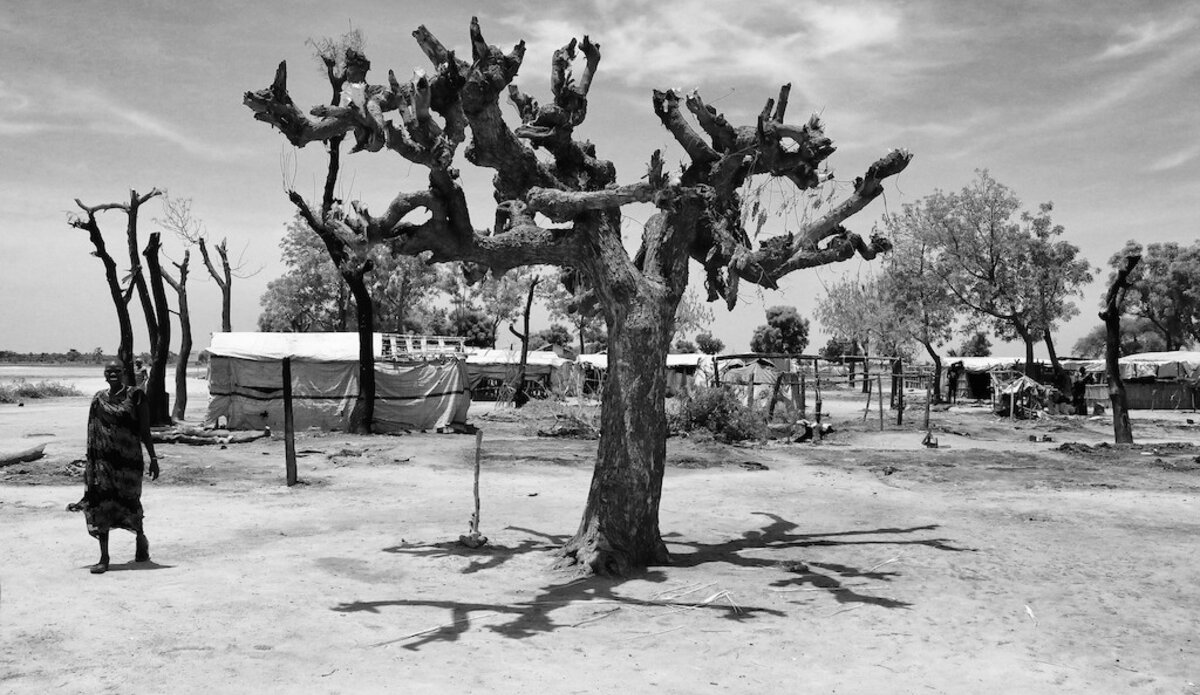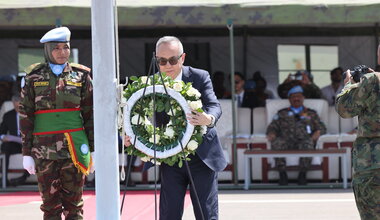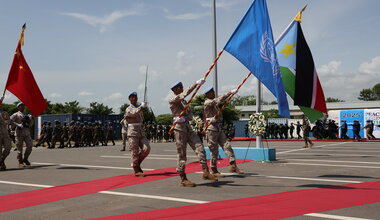Leer County: Relative calm resumes after waves of brutal violence, but humanitarian situation dire
UNITY STATE- Burnt-down or damaged houses, signs of plundering, an eerie silence and empty public spaces not fully explained by the scorching sun tell part of the recent horrific story of Leer County. Survivors tell us the rest.
“My house was razed to the ground. I lost my mother and two of my children. They were killed cold-bloodedly, like so many other people in my village (Pap). All our property was looted, and the nearest place I could run to for protection is here,” says Nyariey Waithie, tears flowing down her cheeks. She is accompanied by some 15,000 other people who have chosen the Muom training centre as their refuge.
The training centre, a half hour drive from Leer town, is a place where soldiers loyal to the government and the main opposition group respectively have spent years, with the intention of practicing together, graduating and forming one, unified national army.
That process has not gone to plan. In fact, the outbursts of fighting that have taken place in the area since January have involved the two parties expected to become one. Such developments may undermine the trust needed for the former foes to interact and cooperate peacefully.
Since violence began, some 181 people are believed to have been killed, including 23 children. Add to that 101 reported incidents of sexual violence, 26 women and children having been abducted and approximately 40,000 people having fled their homes and the magnitude of the devastating impact of the fighting becomes clear. Beheadings and gang rapes underline the cruelty of the perpetrators.
While it is difficult to determine exactly how much of the property damage that has taken place this year and not during previous waves of violence, it is fair to say that nobody seems to have been spared.
Schools, health facilities and churches have suffered, and at least one humanitarian actor’s warehouse has had its supplies looted. No surprise, then, that the aid professionals who could have mitigated some of the widespread hunger and human suffering in the area have been forced to leave, unable to safely perform their critical work as they were.
“We are hoping for humanitarian assistance to arrive, but none is forthcoming,” confirmed Lieutenant Colonel Peter Chuol, supervisor of the Muom training centre for the unified forces. “The situation here is very bad. We have old people and children here and we do not know what to do with them. Children are struggling to survive on just wild fruits,” he went on.
In nearby Thornyor, the peacekeeping team is met by more of the same.
“This used to be our local health facility, but look at it now,” said James Kuok, Gai Payam (administrative division) Administrator for Thornyor, showing the reporters a ransacked hospital building. “I can’t believe how humanitarian workers can be targeted,“ he added, stating that one of the doctors had been killed.
“To be frank, we are wondering whether the revitalized peace agreement is in fact being implemented or not,” the exasperated Administrator said.
 While insecurity prevails, protecting civilians, and critical infrastructure, in the vast area affected by the armed conflict, is a daunting task. The Ghanaian troops based in Leer and serving with the UN peacekeeping mission cannot be everywhere all the time. Several thousands of displaced persons, benefit from the relative safety next to the UNMISS base, but some communities will, at any given time, be vulnerable to sudden attacks.
While insecurity prevails, protecting civilians, and critical infrastructure, in the vast area affected by the armed conflict, is a daunting task. The Ghanaian troops based in Leer and serving with the UN peacekeeping mission cannot be everywhere all the time. Several thousands of displaced persons, benefit from the relative safety next to the UNMISS base, but some communities will, at any given time, be vulnerable to sudden attacks.
“The guns seem to be silent at the moment, but the security situation in Leer remains fragile and the humanitarian reality on the ground continues to be dire,” says Jane Lanyero Kony, Officer-in-Charge of the peacekeeping mission’s field office in Bentiu.
“We have sent more troops to Leer town, and they are working hard to give the internally displaced persons and the local community a sense of relative security. Patrols have been intensified, and in the absence of humanitarian actors, they are also trying to provide emergency supplies like clean drinking water,” she continues, adding that dialogue and discussions with local authorities and other stakeholders are constantly ongoing.
Words cannot, however, no matter how well chosen and spoken they are, feed the people living here, battle-hardened and resilient as they are, and the upcoming rainy season further adds to the despair among them.
But recent developments in Adok, a port town and Unity State’s second-largest economic hub, offer a glimmer of hope. Having last been attacked on 8 April, the lifeline for delivery of humanitarian and other supplies has experienced relative calm since then and is gradually rising from the ashes, according to James Bichok Gatluak, the Adok Payam Administrator.
“People are slowly returning to the port after the massive destruction that took place. Economic activities are resuming, you can see some boats already docking here, and some goods are coming in again. Once humanitarian supplies start arriving, even more civilians will be motivated to come back. It can’t happen soon enough.”
 UN
UN United Nations Peacekeeping
United Nations Peacekeeping





